15 years one-stop China custom CNC machining parts factory
 143 |
Published by VMT at Sep 17 2025 | Reading Time:About 5 minutes
143 |
Published by VMT at Sep 17 2025 | Reading Time:About 5 minutes
Are you choosing between ADC10 and ADC12 aluminum alloys for your next CNC machining project? While both are popular in the die-casting industry, understanding the differences between these two materials can save you time, money, and hassle. ADC10 and ADC12 aluminum alloys each offer distinct properties and benefits, making them ideal for different applications. In this article, we will explore the key differences between ADC10 and ADC12 aluminum, so you can make an informed decision for your next project.
ADC10 and ADC12 aluminum alloys are both commonly used in die-casting, but they differ in chemical composition, mechanical properties, and applications. ADC12 has higher strength and better corrosion resistance, making it ideal for automotive and electronic components. ADC10, on the other hand, offers better fluidity, making it easier to cast complex shapes. Choose based on project needs.
Now that we’ve introduced the topic, let’s dive deeper into what each alloy is and how they compare in terms of properties and performance. Understanding these materials’ chemical composition, mechanical traits, and real-world uses will help you determine which alloy is best for your specific needs.
ADC10 aluminum is a high-performance alloy primarily used in the die-casting industry. It consists of aluminum mixed with other metals like silicon, copper, and magnesium. This alloy offers good fluidity, which allows it to be easily molded into complex shapes, making it a popular choice for high-precision parts in automotive and electronics industries.
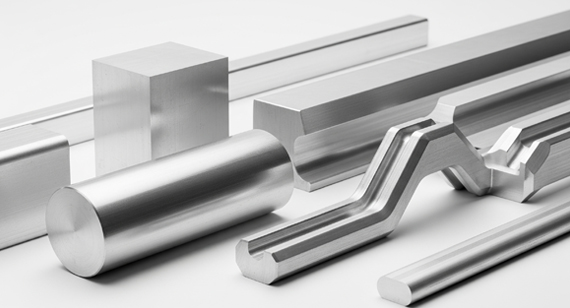
What is ADC10 Equivalent to?
ADC10 aluminum is often considered equivalent to other aluminum alloys like A383, which also serves well in die-casting. Although each alloy has slight variations, ADC10 shares many of its characteristics with A383, especially in terms of strength and casting performance. Understanding these equivalents can help expand your material options without compromising on quality.
ADC12 aluminum, like ADC10, is used extensively in die-casting and is known for its strength and excellent resistance to corrosion. It’s a more durable alloy compared to ADC10, offering higher tensile strength and better performance under stress. ADC12 aluminum is commonly used in applications like automotive parts, electrical casings, and machinery that require high durability.
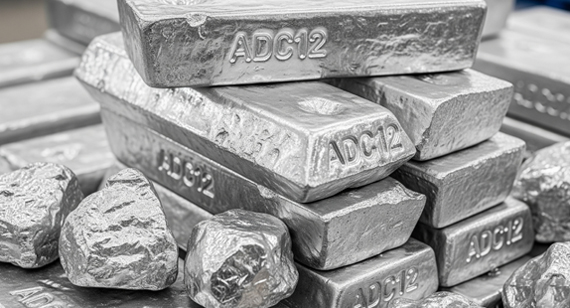
What is ADC12 Equivalent to?
ADC12 aluminum is often compared to A380 and other aluminum alloys like A413. These alloys, while similar, differ in terms of mechanical properties and casting fluidity. ADC12, with its superior corrosion resistance and strength, is often a preferred choice for applications that require robust performance under varying environmental conditions.
When it comes to choosing between ADC10 and ADC12, the differences lie primarily in their mechanical properties and applications. ADC12 is stronger and more resistant to corrosion than ADC10, making it suitable for more demanding environments. However, ADC10 offers superior fluidity, making it easier to cast complex shapes. Knowing these strengths can help you select the right alloy for your specific requirements.
Here's a table summarizing the key differences between ADC10 and ADC12 aluminum alloys:
| Property |
ADC10 Aluminum Alloy |
ADC12 Aluminum Alloy |
| Chemical Composition |
7.0-9.0% Silicon, 3.0-4.5% Copper | 9.0-12.0% Silicon, 3.0-4.0% Copper |
| Tensile Strength |
160-210 MPa | 200-300 MPa |
| Fluidity |
High (easy to cast intricate shapes) | Moderate (less fluid than ADC10) |
| Corrosion Resistance |
Moderate (less resistant in harsh environments) | High (better resistance to corrosion) |
| Strength |
Moderate | High |
| Applications |
Automotive parts, electrical components | Automotive parts, engine casings, pump housings |
| Surface Treatment |
Anodizing and coating can improve corrosion resistance | Less frequent treatment needed due to inherent corrosion resistance |
| Heat Treatment |
Moderate strength after heat treatment | High strength after heat treatment |
| Cost |
Lower cost | Higher cost due to better properties |
This table provides a clear comparison between ADC10 and ADC12 based on key material properties and applications, helping you make an informed decision based on your project’s needs.
Both ADC10 and ADC12 have their advantages and disadvantages. Choosing between them depends on the specific needs of your project. Let’s break down the pros and cons of each to help guide your decision-making process.

ADC10 Aluminum Alloy Advantages and Disadvantages
Advantages:
Disadvantages:
ADC12 Aluminum Alloy Advantages and Disadvantages
Advantages:
Disadvantages:
Here’s a table comparing the advantages and disadvantages of ADC10 and ADC12 aluminum alloys:
| Property |
ADC10 Aluminum Alloy |
ADC12 Aluminum Alloy |
| Advantages | ||
| Fluidity |
Excellent fluidity, ideal for complex shapes | Moderate fluidity, suitable for less intricate designs |
| Cost |
More affordable than ADC12 | Higher cost, but offers long-term durability |
| Ease of Machining |
Easier to machine and mold | More challenging to machine due to higher strength |
| Applications |
Suitable for low-stress parts like electrical components | Ideal for high-stress parts, automotive and industrial applications |
| Casting Efficiency |
Good casting efficiency due to high fluidity | Moderate casting efficiency, especially for detailed parts |
| Disadvantages |
||
| Strength |
Lower tensile strength (160-210 MPa) | Higher tensile strength (200-300 MPa) |
| Corrosion Resistance |
Moderate corrosion resistance | Superior corrosion resistance |
| Durability |
Less durable in harsh environments | More durable, making it ideal for long-lasting applications |
| Fluidity for Intricate Parts |
More prone to issues when casting highly intricate parts | Better for durable parts but less fluid for intricate casting |
| Cost Efficiency |
Lower upfront cost but may lead to higher maintenance costs in the long run | Higher upfront cost but more cost-effective in long-term applications |
This table outlines the key advantages and disadvantages of both alloys, helping you assess which material will be best suited for your needs based on the project requirements.
When selecting the right alloy, it’s important to compare the properties of both ADC10 and ADC12. Let’s look at their chemical composition, mechanical properties, and physical characteristics to determine which material best suits your project.
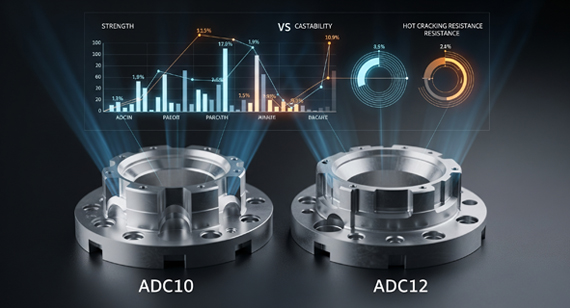
ADC10 Aluminum Alloy vs. ADC12 Aluminum Alloy: Chemical Composition
Here’s a table comparing the chemical composition of ADC10 and ADC12 aluminum alloys:
| Element |
ADC10 Aluminum Alloy |
ADC12 Aluminum Alloy |
| Silicon (Si) |
7.0-9.0% | 9.0-12.0% |
| Copper (Cu) |
3.0-4.5% | 3.0-4.0% |
| Magnesium (Mg) |
0.3-0.9% | 0.3-0.9% |
| Iron (Fe) |
0.5% max | 0.6% max |
| Zinc (Zn) |
0.1% max | 0.1% max |
| Manganese (Mn) |
0.1% max | 0.1% max |
| Titanium (Ti) |
0.1% max | 0.1% max |
| Aluminum (Al) |
Balance (approximately 87.5-91%) | Balance (approximately 84-86%) |
This table highlights the key differences in the chemical composition of ADC10 and ADC12, with ADC12 generally having a higher silicon content, which contributes to its greater strength and corrosion resistance.
ADC10 Aluminum Alloy vs. ADC12 Aluminum Alloy: Mechanical Properties
Here’s a table comparing the mechanical properties of ADC10 and ADC12 aluminum alloys:
| Property |
ADC10 Aluminum Alloy |
ADC12 Aluminum Alloy |
| Tensile Strength |
160-210 MPa | 200-300 MPa |
| Yield Strength |
80-110 MPa | 120-180 MPa |
| Elongation |
2-5% | 2-3% |
| Hardness (Brinell) |
60-80 HB | 80-100 HB |
| Density |
2.68 g/cm³ | 2.68 g/cm³ |
| Modulus of Elasticity |
70-80 GPa | 70-80 GPa |
| Fatigue Strength |
Moderate, typically lower than ADC12 | Higher, more durable under cyclic stress |
| Impact Strength |
Moderate | Higher, better suited for harsh conditions |
This table highlights the key mechanical property differences between ADC10 and ADC12. ADC12 offers superior strength, yield strength, and overall durability compared to ADC10, making it a better choice for high-stress applications.
ADC10 Aluminum Alloy vs. ADC12 Aluminum Alloy: Physical Properties
Here’s a table comparing the physical properties of ADC10 and ADC12 aluminum alloys:
| Physical Property |
ADC10 Aluminum Alloy |
ADC12 Aluminum Alloy |
| Density |
2.68 g/cm³ | 2.68 g/cm³ |
| Melting Point |
570-640°C | 570-640°C |
| Thermal Conductivity |
150 W/m·K | 150 W/m·K |
| Electrical Conductivity |
Moderate (better than copper alloys) | Moderate (better than copper alloys) |
| Coefficient of Thermal Expansion |
22-24 x 10⁻⁶ /°C | 22-24 x 10⁻⁶ /°C |
| Modulus of Elasticity |
70-80 GPa | 70-80 GPa |
| Poisson's Ratio |
0.33 | 0.33 |
| Surface Finish |
Smooth, good casting surface quality | Smooth, slightly better finish capability due to lower porosity |
This table compares the physical properties of ADC10 and ADC12, showing that while both alloys share many characteristics like density, melting point, and thermal conductivity, ADC12 tends to have a slightly better surface finish capability and a marginally lower porosity.
Both alloys are commonly used in die-casting, but their applications differ based on the performance characteristics required.
Here’s a table comparing the applications and uses of ADC10 and ADC12 aluminum alloys:
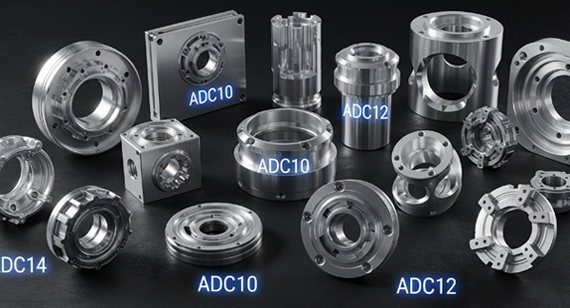
| Application |
ADC10 Aluminum Alloy |
ADC12 Aluminum Alloy |
| Automotive Parts |
Used in engine components, housings, and small parts where lower strength is acceptable | Ideal for high-stress automotive components, engine parts, and transmission housings due to its superior strength |
| Electrical Components |
Suitable for electrical housings and connectors where moderate strength is required | Used for more durable electrical casings, connectors, and high-performance electrical parts |
| Industrial Machinery |
Best for low-stress parts like pump components and brackets | Ideal for high-load machinery parts, gears, and structural components |
| Consumer Electronics |
Used in lightweight enclosures and internal parts for gadgets and devices | Suitable for durable, high-performance enclosures in electronics like power tools |
| Aerospace Applications |
Suitable for lightweight, non-critical aerospace components | Often used for critical aerospace parts that require better strength and durability |
| Marine Components |
Used for less demanding marine parts with moderate exposure to corrosion | Preferred for parts exposed to harsh marine environments due to superior corrosion resistance |
| Die-Casting |
Common in low-stress die-cast applications | Common in high-performance die-cast applications requiring strength and corrosion resistance |
This table provides an overview of the key applications and uses of both ADC10 and ADC12, helping you decide which material is best suited for your project based on performance and environmental requirements.
Both ADC10 and ADC12 can undergo surface treatments like anodizing and coating to enhance corrosion resistance. However, ADC12, due to its superior corrosion resistance, may require less intensive surface treatment for certain applications.
Here’s a table comparing the surface treatment options for ADC10 and ADC12 aluminum alloys:
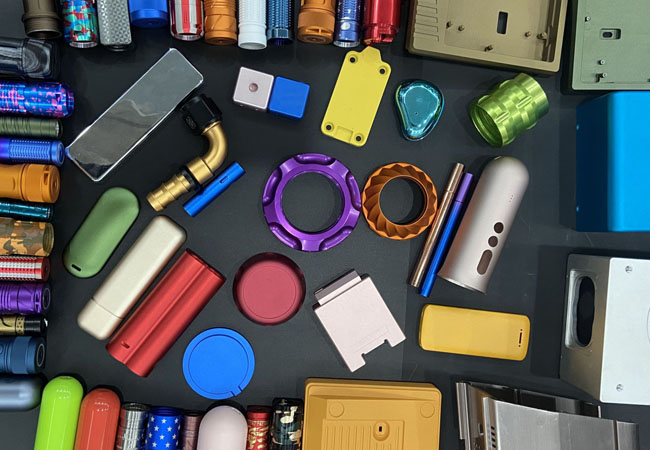
| Surface Treatment |
ADC10 Aluminum Alloy |
ADC12 Aluminum Alloy |
| Anodizing |
Can be anodized to improve corrosion resistance and surface hardness, but may require more effort due to its lower strength | Anodizing is highly effective, improving both corrosion resistance and surface hardness, making it ideal for long-lasting applications |
| Powder Coating |
Suitable for powder coating; results in a smooth and durable finish, but less resistant to scratches compared to ADC12 | Also suitable for powder coating; offers a smoother and more durable finish, with better scratch resistance and corrosion protection |
| Chromate Conversion Coating |
Provides good corrosion resistance, commonly used for automotive parts | Effective for corrosion protection, often used in aerospace and industrial applications for higher durability |
| Polishing |
Can be polished to a smooth finish, but may not have the same luster and durability as ADC12 | Polishes well and provides a superior glossy finish, especially for visible parts in high-end applications |
| Painting |
Paint adheres well, though surface preparation is key for best results | Paint adheres excellently, providing a high-quality finish, and is preferred for consumer-facing parts |
| Heat Treatment |
Can be heat treated to improve hardness and durability | Heat treatment enhances its strength and resistance to wear and tear more effectively than ADC10 |
| Coating for Marine Applications |
Requires additional surface treatments like coatings to improve saltwater resistance | Better natural corrosion resistance, requiring fewer coatings for marine applications |
This table summarizes the surface treatment options for both ADC10 and ADC12, highlighting their suitability for different applications based on their inherent properties and performance after treatment.
Both alloys benefit from heat treatment, but ADC12 can achieve higher strength levels after treatment due to its enhanced alloy composition.
Here’s a table comparing the heat treatment of ADC10 and ADC12 aluminum alloys:

| Heat Treatment Type |
ADC10 Aluminum Alloy |
ADC12 Aluminum Alloy |
| Solution Heat Treatment |
Not typically used due to lower strength requirements | Can be solution heat treated to enhance strength and improve mechanical properties |
| Aging (Artificial Aging) |
Aging is not commonly required, but it can improve hardness slightly | Artificial aging improves strength and durability, particularly for high-stress applications |
| Annealing |
Can be annealed for softening or stress relief, but has limited benefits | Annealing can be used for stress relief and further strength enhancement |
| Quenching |
Not commonly required due to lower strength demands | Quenching after solution heat treatment can significantly enhance tensile strength |
| Stress Relief |
Stress relief treatment can be applied to reduce internal stresses after casting | Effective for reducing internal stresses, improving dimensional stability in complex parts |
| Effect on Strength |
Limited increase in strength after heat treatment | Significant increase in tensile and yield strength after heat treatment |
| Effect on Machinability |
Slightly improves machinability after heat treatment | Machinability remains relatively the same after heat treatment but with better overall strength |
|
Effect on Hardness |
Slight increase in hardness, but not significant | Significant increase in hardness after aging, making it suitable for high-performance applications |
This table compares the heat treatment characteristics of ADC10 and ADC12, demonstrating how ADC12 benefits more significantly from heat treatments to enhance its strength and durability, especially for demanding applications.
Cost is a significant factor when deciding between ADC10 and ADC12. Let’s break down how their prices compare in different contexts, including raw material cost, CNC machining, and post-processing.
Raw Material Cost
Initial Cost Comparison
Long-Term Cost Benefits
CNC Machining Costs
Post-Processing Costs
Here’s a table comparing the cost and price aspects of ADC10 and ADC12 aluminum alloys:
| Cost Factor |
ADC10 Aluminum Alloy |
ADC12 Aluminum Alloy |
| Raw Material Cost |
Lower cost due to simpler composition | Higher cost due to higher silicon content and improved properties |
| Initial Material Cost |
More affordable for mass production or low-budget projects | More expensive upfront, but offers higher durability and performance |
| CNC Machining Cost |
Lower machining costs due to its easier workability | Higher machining costs due to increased hardness and toughness |
| Post-Processing Costs |
Generally lower post-processing costs | Higher post-processing costs due to its tougher material and additional treatment requirements |
| Long-Term Cost Benefits |
Lower upfront cost, but may require more frequent maintenance or part replacements | Higher initial cost, but offers better long-term durability, reducing maintenance and replacement costs |
| Casting Cost |
More cost-effective for simple castings | Higher casting costs, especially for detailed or high-strength parts |
| Cost Efficiency for High-Volume Production |
More cost-effective in high-volume production due to lower material costs and easier machining | Less cost-effective in high-volume production due to higher material and machining costs |
This table highlights the cost differences between ADC10 and ADC12, helping you decide which material offers the best cost-effectiveness based on your project’s scope, machining needs, and long-term goals.
Choosing the right aluminum alloy for your project depends on several factors, including cost, strength, fluidity, and environmental conditions. Let’s break down when to choose each alloy.
When to Choose ADC10 Aluminum Alloy?
When to Choose ADC12 Aluminum Alloy?
Here’s a table summarizing how to choose between ADC10 and ADC12 aluminum based on different project needs:
| Criteria |
Choose ADC10 Aluminum Alloy |
Choose ADC12 Aluminum Alloy |
| Strength Requirements |
Low to moderate strength requirements | High strength and durability needed |
| Corrosion Resistance |
Moderate corrosion resistance (requires treatment in harsh environments) | Superior corrosion resistance (ideal for harsh conditions) |
| Casting Complexity |
Suitable for casting complex shapes due to high fluidity | Suitable for less intricate designs but better overall strength |
| Cost Sensitivity |
Lower material and machining costs, suitable for budget-friendly projects | Higher cost, better suited for long-term, high-performance applications |
| Machinability |
Easier to machine, ideal for simple and high-volume production | More difficult to machine, ideal for high-precision, high-strength parts |
| Applications |
Automotive parts, electrical enclosures, consumer electronics | Automotive engine parts, industrial machinery, aerospace components |
| Durability Needs |
Suitable for low-stress or non-critical applications | Better for parts exposed to high wear, stress, or environmental factors |
| Post-Processing Requirements |
Lower post-processing costs due to softer material | Higher post-processing costs but enhanced performance after treatment |
| Long-Term Performance |
May require more frequent replacements or maintenance | Superior long-term performance, especially under stress and harsh environments |
| Environmental Considerations |
Suitable for indoor or light-duty applications | Ideal for outdoor, marine, or high-corrosion environments |
This table provides a clear guide to help you decide whether ADC10 or ADC12 is best suited for your project based on factors like strength, cost, and application requirements.
If you're uncertain which alloy to choose, consider the specific requirements of your project. If fluidity and ease of casting are essential, ADC10 may be the way to go. For projects demanding high strength and resistance to wear and corrosion, ADC12 is the superior option.
To help you determine if ADC10 and ADC12 aluminum alloys are right for your project, consider the following key points:
1. Project Strength Requirements
2. Corrosion Resistance
3. Cost Considerations
4. Machinability
5. Project Lifecycle and Durability
6. Specific Application Needs
Conclusion: Are ADC10 and ADC12 Right for Your Project?
Understanding your project’s specific requirements in terms of strength, durability, cost, and application will guide you in making the right choice between ADC10 and ADC12.
At VMT, we specialize in providing high-quality CNC machining services for both ADC10 aluminum and ADC12 aluminum alloys. Whether you’re working on a budget-friendly project or need high-performance components, we have the expertise and resources to meet your specific needs. Our team uses the latest CNC machining technology to deliver precise, durable, and cost-effective solutions tailored to your project requirements.
Why Choose VMT for Your ADC10 and ADC12 CNC Machining Needs?
Expertise in Aluminum Alloys
We have years of experience working with ADC10 and ADC12 aluminum, allowing us to deliver parts with exceptional precision and reliability. Our team understands the unique properties of each alloy and how to optimize them for your application.
High-Quality CNC Machining Services
Whether you need ADC10 aluminum CNC machined parts for simple, high-volume projects, or ADC12 aluminum CNC machined parts for complex, high-strength applications, we have the capabilities to produce high-quality parts with tight tolerances. We focus on both performance and cost-efficiency.
Custom Solutions for Every Industry
From automotive to aerospace, industrial machinery, and consumer electronics, we cater to a wide range of industries. Our CNC machining factory can produce components that meet specific strength, corrosion resistance, and durability needs, ensuring your parts are perfectly suited for their intended application.
Fast Turnaround Times
We understand that time is of the essence. Our streamlined processes and efficient production methods ensure that your CNC machining parts are delivered quickly without compromising on quality.
Advanced Post-Processing and Finishing
In addition to machining, we offer a variety of post-processing services such as anodizing, powder coating, and heat treatments to enhance the performance and appearance of your parts. Whether you need ADC10 aluminum anodized parts or ADC12 aluminum parts with corrosion-resistant coatings, we’ve got you covered.
Cost-Effective Solutions
We offer competitive pricing for both ADC10 and ADC12 aluminum parts, ensuring you get the best value without compromising on quality. Whether your project is large or small, we tailor our services to meet your budget and production needs.
How Our ADC10 and ADC12 CNC Machining Services Benefit You:
Get in Touch with VMT for ADC10 and ADC12 Aluminum Alloy CNC Machining Parts
If you’re ready to take your project to the next level, VMT is here to help. Whether you need ADC10 aluminum CNC machined parts or ADC12 aluminum CNC machined parts, we provide tailored solutions that meet your specific performance and budget needs. Our team is committed to delivering high-quality products with fast turnaround times and exceptional customer service.
Contact us today to discuss your ADC10 and ADC12 aluminum CNC machining needs, and let us help you find the perfect solution for your next project!
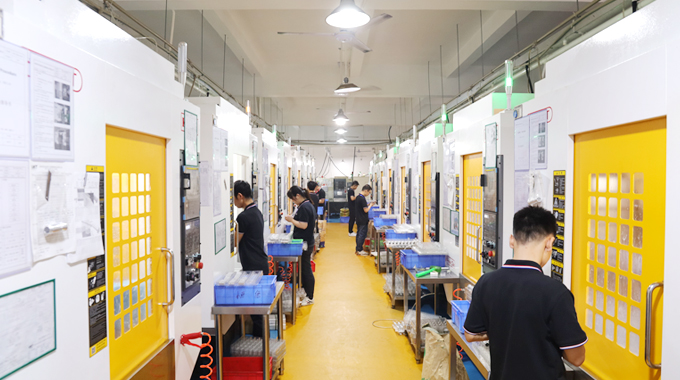
Choosing the right aluminum alloy—ADC10 or ADC12—is crucial for the success of your CNC machining project. Both alloys offer distinct advantages, with ADC10 being a cost-effective solution for simpler, low-stress applications, and ADC12 providing superior strength and corrosion resistance for high-performance, demanding environments. Understanding the key differences between these alloys, including their properties, applications, and cost implications, is essential to making an informed decision.
At VMT, we specialize in ADC10 aluminum and ADC12 aluminum CNC machining parts and offer customized solutions tailored to your specific needs. Whether you're working on a budget-friendly project or require high-performance components, our team is ready to provide you with the best quality, fast turnaround, and cost-effective solutions.
By choosing the right alloy for your project, you can ensure the durability, functionality, and cost-efficiency of your machined parts. Contact VMT today to learn more about our CNC machining services and how we can help you with your ADC10 and ADC12 aluminum needs. We’re committed to delivering precision, reliability, and top-quality results for all your aluminum CNC machining projects.
Why use ADC12?
ADC12 is widely used for its superior strength, corrosion resistance, and durability. It is ideal for applications requiring high-performance and reliability, such as automotive engine parts, industrial machinery, and electronics. Its excellent casting properties make it suitable for intricate designs, while its enhanced corrosion resistance makes it perfect for harsh environments like marine applications.
What is the difference between A380 and ADC12?
A380 and ADC12 are both aluminum alloys used in die-casting, but they differ in composition and properties. A380 has better fluidity, which makes it easier to cast intricate parts, but ADC12 offers superior strength and corrosion resistance. A380 is often used in general automotive applications, while ADC12 is chosen for higher-strength components, especially in automotive and industrial sectors.
What is the difference between ADC12 and ADC6?
ADC12 and ADC6 are both aluminum die-casting alloys, but ADC12 offers better overall strength and corrosion resistance, making it suitable for higher-performance applications. ADC6, on the other hand, is often used for less demanding applications and is more cost-effective. ADC12 has a higher silicon content, contributing to its increased durability and performance.
What is the difference between ADC3 and ADC12?
ADC3 and ADC12 are both aluminum alloys used in die-casting, but ADC12 provides better strength, corrosion resistance, and overall durability compared to ADC3. ADC12 is often used for higher-performance applications that require long-lasting parts, while ADC3 is used in lighter-duty applications where lower strength is sufficient.
Which alloy offers better corrosion resistance?
ADC12 offers significantly better corrosion resistance compared to ADC10 and many other aluminum alloys, making it more suitable for applications exposed to harsh environments like marine and industrial settings. ADC12's higher silicon content helps improve its ability to withstand oxidation and corrosion over time.
Can ADC12 aluminum die-cast alloy be welded effectively?
Yes, ADC12 aluminum can be welded effectively, but it requires proper preparation due to its higher silicon content, which can make it more challenging to weld compared to other alloys. Specialized techniques, such as TIG (Tungsten Inert Gas) welding, are often used to achieve high-quality welds on ADC12.
What is the difference between 13Cr and SS 410?
13Cr (13% Chromium steel) and SS 410 (a type of stainless steel) are both martensitic steels, but 13Cr typically offers higher corrosion resistance due to its higher chromium content. SS 410 is often used in applications where moderate corrosion resistance and strength are needed. 13Cr is commonly found in high-temperature and aggressive chemical environments, while SS 410 is more commonly used in general engineering and valve components.
What is the equivalent of ADC6?
The equivalent of ADC6 can vary based on the specific requirements of your project. It is often compared to alloys like A383 or A356, depending on the application. While these alloys share similar casting and mechanical properties, ADC6 is typically chosen for its good fluidity and ease of casting for general-purpose applications.
What is ADC3?
ADC3 is an aluminum alloy used in die-casting applications, typically offering moderate strength and good fluidity. It is a cost-effective choice for casting parts that do not require high-performance properties. ADC3 is commonly used for automotive and consumer electronics applications that demand lower strength and better casting properties at a lower cost.
